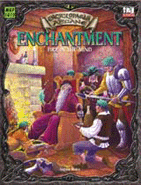
|
About OgreCave and its staff
|

|
by Joe G. Kushner
The Encylopaedia Arcane series started with the evil topics of Demonology and Necromancy and has worked its way around to concepts like Chaos Magic and more popular schools of magic like Battle Magic and Constructs. In Enchantment: Fire in the Mind, the series takes on a more traditional school.
Falling Under Its Spell "Usurping the Will" is another section that helps round out characters but seems a little obvious in some places. I donít need a book on Enchantment to tell me that itís important to have spells like Mage Armor and keep crossbows and staffs at the ready just in case. Thatís mage survival 101! What does make sense though is trying to make sure that when you cast your spells that youíre subtle and your manipulations of the target arenít brutal. If nothing else, these tips will help insure that youíre not on the "destroy immediately" list of anyone who isnít charmed by you. Four prestige classes are detailed in the book to add variety to the Enchantment school:
Even those not using a prestige class will enjoy the Spells of Enchantment. While the section is missing a breakdown of spells by level and class, it does provide a nice selection of spells from low to high level with an enchantment focus. The spells contained in this large section are well done thoughout and provide a lot of opportunities for enchanters to strut their stuff from 1st level through 20th level. Take Bonded Souls, for example. This 7th level arcane spell insures that the target wonít attack him, because if the mage who cast the spell dies, even within an hour of the spell being broken, thereís a good chance the bonded individual dies too. That's not even the spellís main purpose. Instead, Bonded Souls was mainly designed for the casting of touch-ranged spells and personal affecting spells as if the target was your familiar. The death insurance is just a bonus. Those looking for something a little less powerful can use Confidante, a 3rd level spell that enables the caster to become the best friend who is trusty enough to hear any information thatís not going to result in getting someone the target cares about killed. There are other areas that PCs look at to augment their characters though, and Feats arenít missed here. Take Absolute Authority: sure, it has some rigorous requirements, but it allows the caster to make a Charisma check to reinstall a spell upon the target. Nice, eh? More impressive perhaps is Mark of the Master, a feat that provides the user different abilities based on his level + charisma bonus and can be taken multiple times. For example, if you're level and charisma bonus is within the 5-8 range, you get a +1 DC bonus to your spells that stacks with Spell Focus and other similiar feats while if you have a 25+ total, you've got a kiss that can either knock out an opponent or kill him. One thing different about enchanters when compared to most other spellcasters is they often have living servants. Not undead or constructs, but living, breathing people. The section on Thralls provides information on how to break down the mind, complete with game mechanics. Itís a timely process and one prone to error, but a diligent and patient enchanter can have minions willing to do anything for them from fighting to the death to committing suicide to insure that their master is happy. When a Thrall is created, they actually get a template that provides them some bonuses but destroys their wisdom in the process. One section I was a little surprised to see here was Magical Items. I mean sure, enchanters need them just as much as anyone else but Heartbreaker, a greatsword with attitude, is a very cool weapon that could be the goal of a long-term campaign where its darker nature isnít known. Other items, like the Potion of Ennui and Armband of Mental Fortitude, help those who seek to resist the power of enchantment, while other items like the Ring of Infernal Delight and the Staff of Mindmastery provide spells of enchantment to the user. Newer GMs will enjoy the section "Help for Game Masters," as this school, even without the flash and bang of a fireball, can have long lasting effects on a campaign. The advice deals with potentially serious issues, such as the enchanter turning his power on his friends. There are also rules for will save modifiers based on external conditions like starvation, sleep deprivation and other good old mind bending techniques. One of the worst parts of the book is the story of a master and his apprentice that's threaded through the sections, but it gets a little more interesting towards the end. My main problem with it is that it takes up too much space. Iím not too fond of fiction in most cases, but stories like this one provide some connection to the material in a moving fashion as each piece relates to the section its in. The book is laid out in standard two-column format with art ranging from okay to great. The front interior cover is used for a full color picture of a party walking into a city with what looks like an enchanter waving away a guard, while the rear interior cover provides the Thrall template for easy copying. Outer and top borders are about an inch while bottom and interior borders are much closer.
Conclusions
|
||
 Enchantment: Fire in the Mind
Enchantment: Fire in the Mind